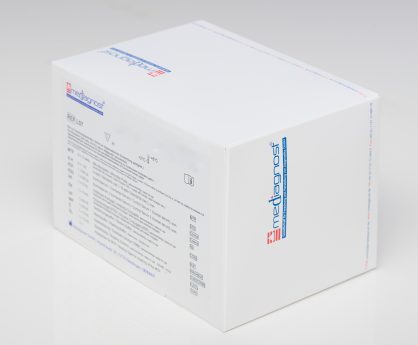Human IGFBP-1 ELISA Assay
The Human IGFBP-1 ELISA Assay is For Research Use Only
Size: 1×96 wells
Sensitivity: 0.02 ng/ml
Incubation Time: 1.75 hours
Sample Type: Serum, Plasma, Saliva, Breast Milk, Urine, Other Bodily Fluids
Sample Size: 20 µL
Product is manufactured by Mediagnost
Assay Background
The Insulin-like Growth Factors I and – II are free in body fluids and tissues but are bound to specific binding proteins. Until today seven different binding proteins (IGFBP-1 to –7) can be differentiated additionally several IGFBP-related proteins have also been detected. Bioavailability of IGF is regulated by these IGFBPs or better their proteolytic cleavage which reduces affinity to IGF. But the IGFBPs, as well as their proteolytic fragments, can also exert IGF-independent effects, like influencing cell migration or proliferation. IGFBP-1 (Placental Protein 12) consists of 234 amino acids and has a molecular weight of approximately 25kDa. The coding DNA region is located on chromosome 7. IGFBP-1 is mainly synthesized by foetal and adult liver tissue and decidual endometrium. Intensity of Expression varies enduring menstruation with a maximal expression in the late secretory phase. Further IGFBP-1 expression seems to be regulated by Insulin concentration, with Insulin inhibiting the expression. Insulin regulation results in diurnal fluctuations of up to factor 10. IGFBP-1 is posttranslationally modified by phosphorylation of serine residues 101, 119 and 169. Phosphorylation has physiological relevance as it increases affinity of IGFBP-1 to IGF. In adult humans, phosphorylated IGFBP-1 of the liver is the predominant form in circulation. IGFBP-1 produced by endometrial tissue is significantly less phosphorylated than the liver originated form.
In pregnancy IGFBP-1 maternal serum concentration increases significantly with maximal values in the second trimester or 22-23 week of gestation (75.8 ng/ml) and decreases slowly until term. IGFBP-1 concentration are not only increased in maternal but also in fetal serum and with extremely high concentrations in amnion fluid. Here concentration can reach more than the 1000-fold of serum values. Long-term changes of serum IGFBP-1 concentration can also be found in amnion fluid: IGFBP-1 level of the child decreases after birth until it reaches the low steady-state level of puberty and adulthood. Short term IGFBP-1 serum concentration is strongly influenced by nutrition level and therewith by insulin. Decreasing IGFBP-1 levels can be found enduring fasting or in diabetes; IGFBP-1 levels increase in case of intensive exercises. Relevance of serum and amnion IGFBP-1 in diagnostics has been investigated in several areas. A diagnostic value was assigned for trisomy 18, intrauterine growth retardation, endometrial tumors and pre-eclampsia. Thoroughly investigated were the diagnostic value in insulin resistance and pre-term rupture of the membrane and especially in the second field, a significant diagnostic value could be demonstrated.
Related Products
IGFBP-2 ELISA Assay Kit
IGFBP-3 ELISA Assay Kit
Insulin-Like Growth Factor Binding Protein-1 ELISA


